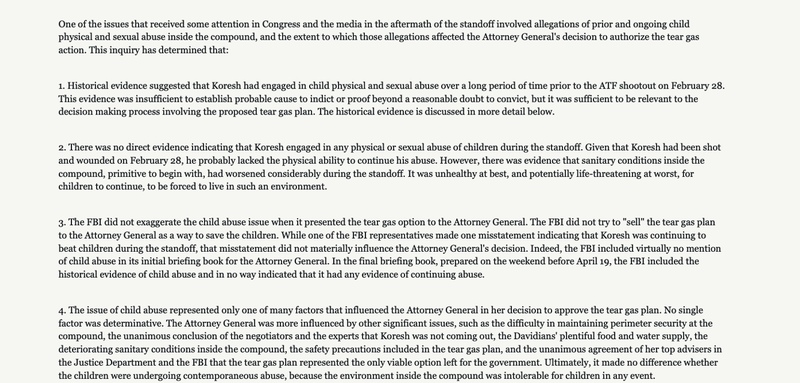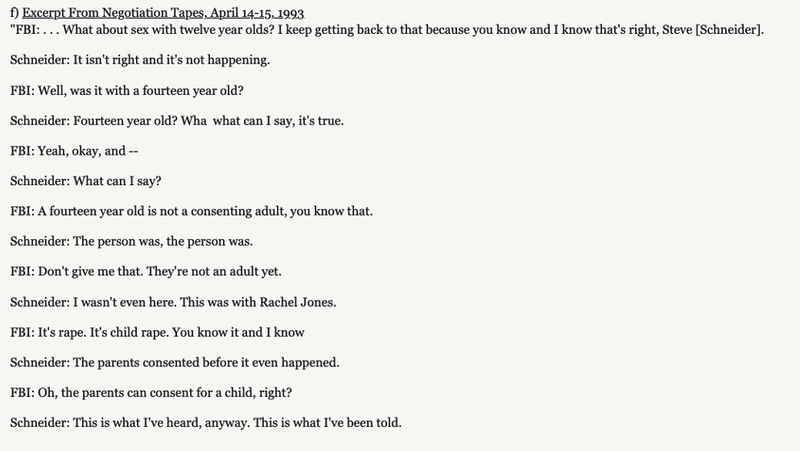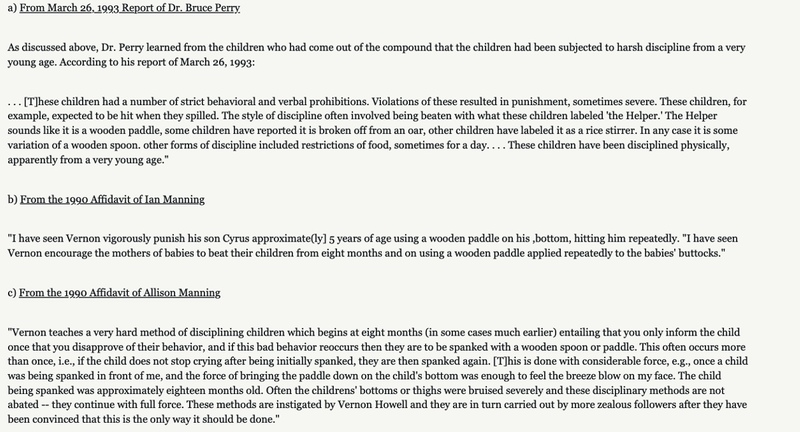Branch Davidian Evidence of Child Abuse
Dublin Core
Title
Branch Davidian Evidence of Child Abuse
Subject
Child abuse in the Branch Davidian cult
Description
Examining the allegations of child abuse is important not only in understanding attorney general Janet Reno’s approval of tear gas and subsequent demise of the Branch Davidian compound, but also for the culture of the Branch Davidians and David Koresh as a person. Los Angeles Times Glenn Bunting posits that the military and ATF “played up” the level of abuse within the compound in order to secure approval for tear gas, but the federal government maintains that they did not exaggerate their claims. According to several FBI interviews of the children who escaped the siege and former adult cult members, it was common knowledge that Koresh physically abused the children, beating some as young as months old with a wooden paddle known as “the helper,” leaving bruises and welts. In addition, Koresh allegedly had multiple wives who were girls as young as ten and raped them. Unfortunately, the victims did not understand the concept of rape or sexual assault, and instead were encouraged by their parents to think it was a great privilege to be assaulted by Koresh. This highlights the level of delusion and brainwashing held by the members of the cult, being in so deep that they could not understand how child rape was wrong. Even today, former cult members claim that they did not see Koresh’s abuse as sexual assault and continue to believe in Koresh’s God-like power and authority.
Creator
Department of Justice
Source
U.S. Department of Justice. "Report to the Attorney General on the Events at Waco, Texas." Department of Justice, February 28, 1993, https://www.justice.gov/ archives/publications/waco/report-deputy-attorney-general-events-waco-texas-child-abuse
Bunting, Glenn. "Use of Tear Gas in Waco Raid Under Scrutiny : Siege: Experts raise safety questions. Reno says she was assured substance would not harm children." <em>Los Angeles Times</em>. 29 May 1995.
Publisher
The United States Department of Justice
Date
February 28, 1993
Contributor
Department of Justice
Rights
Public Archives
Format
Online
Language
English
Type
Report
Identifier
https://www.justice.gov/archives/publications/waco/report-deputy-attorney-general-events-waco-texas-child-abuse
Coverage
United States of America
Text Item Type Metadata
Text
A. Introduction
One of the issues that received some attention in Congress and the media in the aftermath of the standoff involved allegations of prior and ongoing child physical and sexual abuse inside the compound, and the extent to which those allegations affected the Attorney General's decision to authorize the tear gas action. This inquiry has determined that:
1. Historical evidence suggested that Koresh had engaged in child physical and sexual abuse over a long period of time prior to the ATF shootout on February 28. This evidence was insufficient to establish probable cause to indict or proof beyond a reasonable doubt to convict, but it was sufficient to be relevant to the decision making process involving the proposed tear gas plan. The historical evidence is discussed in more detail below.
2. There was no direct evidence indicating that Koresh engaged in any physical or sexual abuse of children during the standoff. Given that Koresh had been shot and wounded on February 28, he probably lacked the physical ability to continue his abuse. However, there was evidence that sanitary conditions inside the compound, primitive to begin with, had worsened considerably during the standoff. It was unhealthy at best, and potentially life-threatening at worst, for children to continue, to be forced to live in such an environment.
3. The FBI did not exaggerate the child abuse issue when it presented the tear gas option to the Attorney General. The FBI did not try to "sell" the tear gas plan to the Attorney General as a way to save the children. While one of the FBI representatives made one misstatement indicating that Koresh was continuing to beat children during the standoff, that misstatement did not materially influence the Attorney General's decision. Indeed, the FBI included virtually no mention of child abuse in its initial briefing book for the Attorney General. In the final briefing book, prepared on the weekend before April 19, the FBI included the historical evidence of child abuse and in no way indicated that it had any evidence of continuing abuse.
4. The issue of child abuse represented only one of many factors that influenced the Attorney General in her decision to approve the tear gas plan. No single factor was determinative. The Attorney General was more influenced by other significant issues, such as the difficulty in maintaining perimeter security at the compound, the unanimous conclusion of the negotiators and the experts that Koresh was not coming out, the Davidians' plentiful food and water supply, the deteriorating sanitary conditions inside the compound, the safety precautions included in the tear gas plan, and the unanimous agreement of her top advisers in the Justice Department and the FBI that the tear gas plan represented the only viable option left for the government. Ultimately, it made no difference whether the children were undergoing contemporaneous abuse, because the environment inside the compound was intolerable for children in any event.
B. Evidence of Historical Child Sexual and Physical Abuse
1. Sexual Abuse
Rumors about Koresh's sexual practices with girls persisted for years prior to the ATF raid. Former compound members told stories about Koresh's alleged practice of having sex with girls as young as twelve. Evidence suggested that Koresh had "wives" who were in their mid-teens, that Koresh told detailed and inappropriate sexual stories in front of the children during his Bible study sessions, and that Koresh taught the young girls that it was a privilege for them to become old enough (i.e., reach puberty) to have sex with him. One former compound member described how Koresh would invent theological justifications for his sexual desires, whether they involved having sex with young girls or with other men's adult wives. According to information provided to the FBI, at least two minor girls were "wives" of Koresh at the time of the standoff.
The following are excerpts from materials compiled by the FBI during the standoff providing examples of Koresh's historical (i.e., pre-February 28, 1993) sexual practices with young girls.
a) From ATF Affidavit in Support of Arrest of Koresh
From ATF Special Agent Aguilera's interview of former compound resident Jeannine Bunds, included in Agent Aguilera's affidavit in support of the Koresh arrest warrant, February 25, 1993:
"Ms. Bunds also told me that Howell had fathered at least fifteen (15) children with various women and young girls at the compound. Some of the girls who had babies fathered by Howell were as young as 12 years old. She had personally delivered seven (7) of these children.
According to Ms. Bunds, Howell annuls all marriages of couples who join his cult. He then has exclusive sexual access to the women. He also, according to Ms. Bunds, has regular sexual relations with young girls there. The girls' ages are from eleven (11) years old to adulthood."
2. Physical Abuse
a) From March 26, 1993 Report of Dr. Bruce Perry
As discussed above, Dr. Perry learned from the children who had come out of the compound that the children had been subjected to harsh discipline from a very young age. According to his report of March 26, 1993:
. . . [T]hese children had a number of strict behavioral and verbal prohibitions. Violations of these resulted in punishment, sometimes severe. These children, for example, expected to be hit when they spilled. The style of discipline often involved being beaten with what these children labeled 'the Helper.' The Helper sounds like it is a wooden paddle, some children have reported it is broken off from an oar, other children have labeled it as a rice stirrer. In any case it is some variation of a wooden spoon. other forms of discipline included restrictions of food, sometimes for a day. . . . These children have been disciplined physically, apparently from a very young age."
c) From the 1990 Affidavit of Allison Manning
"Vernon teaches a very hard method of disciplining children which begins at eight months (in some cases much earlier) entailing that you only inform the child once that you disapprove of their behavior, and if this bad behavior reoccurs then they are to be spanked with a wooden spoon or paddle. This often occurs more than once, i.e., if the child does not stop crying after being initially spanked, they are then spanked again. [T]his is done with considerable force, e.g., once a child was being spanked in front of me, and the force of bringing the paddle down on the child's bottom was enough to feel the breeze blow on my face. The child being spanked was approximately eighteen months old. Often the childrens' bottoms or thighs were bruised severely and these disciplinary methods are not abated -- they continue with full force. These methods are instigated by Vernon Howell and they are in turn carried out by more zealous followers after they have been convinced that this is the only way it should be done."
One of the issues that received some attention in Congress and the media in the aftermath of the standoff involved allegations of prior and ongoing child physical and sexual abuse inside the compound, and the extent to which those allegations affected the Attorney General's decision to authorize the tear gas action. This inquiry has determined that:
1. Historical evidence suggested that Koresh had engaged in child physical and sexual abuse over a long period of time prior to the ATF shootout on February 28. This evidence was insufficient to establish probable cause to indict or proof beyond a reasonable doubt to convict, but it was sufficient to be relevant to the decision making process involving the proposed tear gas plan. The historical evidence is discussed in more detail below.
2. There was no direct evidence indicating that Koresh engaged in any physical or sexual abuse of children during the standoff. Given that Koresh had been shot and wounded on February 28, he probably lacked the physical ability to continue his abuse. However, there was evidence that sanitary conditions inside the compound, primitive to begin with, had worsened considerably during the standoff. It was unhealthy at best, and potentially life-threatening at worst, for children to continue, to be forced to live in such an environment.
3. The FBI did not exaggerate the child abuse issue when it presented the tear gas option to the Attorney General. The FBI did not try to "sell" the tear gas plan to the Attorney General as a way to save the children. While one of the FBI representatives made one misstatement indicating that Koresh was continuing to beat children during the standoff, that misstatement did not materially influence the Attorney General's decision. Indeed, the FBI included virtually no mention of child abuse in its initial briefing book for the Attorney General. In the final briefing book, prepared on the weekend before April 19, the FBI included the historical evidence of child abuse and in no way indicated that it had any evidence of continuing abuse.
4. The issue of child abuse represented only one of many factors that influenced the Attorney General in her decision to approve the tear gas plan. No single factor was determinative. The Attorney General was more influenced by other significant issues, such as the difficulty in maintaining perimeter security at the compound, the unanimous conclusion of the negotiators and the experts that Koresh was not coming out, the Davidians' plentiful food and water supply, the deteriorating sanitary conditions inside the compound, the safety precautions included in the tear gas plan, and the unanimous agreement of her top advisers in the Justice Department and the FBI that the tear gas plan represented the only viable option left for the government. Ultimately, it made no difference whether the children were undergoing contemporaneous abuse, because the environment inside the compound was intolerable for children in any event.
B. Evidence of Historical Child Sexual and Physical Abuse
1. Sexual Abuse
Rumors about Koresh's sexual practices with girls persisted for years prior to the ATF raid. Former compound members told stories about Koresh's alleged practice of having sex with girls as young as twelve. Evidence suggested that Koresh had "wives" who were in their mid-teens, that Koresh told detailed and inappropriate sexual stories in front of the children during his Bible study sessions, and that Koresh taught the young girls that it was a privilege for them to become old enough (i.e., reach puberty) to have sex with him. One former compound member described how Koresh would invent theological justifications for his sexual desires, whether they involved having sex with young girls or with other men's adult wives. According to information provided to the FBI, at least two minor girls were "wives" of Koresh at the time of the standoff.
The following are excerpts from materials compiled by the FBI during the standoff providing examples of Koresh's historical (i.e., pre-February 28, 1993) sexual practices with young girls.
a) From ATF Affidavit in Support of Arrest of Koresh
From ATF Special Agent Aguilera's interview of former compound resident Jeannine Bunds, included in Agent Aguilera's affidavit in support of the Koresh arrest warrant, February 25, 1993:
"Ms. Bunds also told me that Howell had fathered at least fifteen (15) children with various women and young girls at the compound. Some of the girls who had babies fathered by Howell were as young as 12 years old. She had personally delivered seven (7) of these children.
According to Ms. Bunds, Howell annuls all marriages of couples who join his cult. He then has exclusive sexual access to the women. He also, according to Ms. Bunds, has regular sexual relations with young girls there. The girls' ages are from eleven (11) years old to adulthood."
2. Physical Abuse
a) From March 26, 1993 Report of Dr. Bruce Perry
As discussed above, Dr. Perry learned from the children who had come out of the compound that the children had been subjected to harsh discipline from a very young age. According to his report of March 26, 1993:
. . . [T]hese children had a number of strict behavioral and verbal prohibitions. Violations of these resulted in punishment, sometimes severe. These children, for example, expected to be hit when they spilled. The style of discipline often involved being beaten with what these children labeled 'the Helper.' The Helper sounds like it is a wooden paddle, some children have reported it is broken off from an oar, other children have labeled it as a rice stirrer. In any case it is some variation of a wooden spoon. other forms of discipline included restrictions of food, sometimes for a day. . . . These children have been disciplined physically, apparently from a very young age."
c) From the 1990 Affidavit of Allison Manning
"Vernon teaches a very hard method of disciplining children which begins at eight months (in some cases much earlier) entailing that you only inform the child once that you disapprove of their behavior, and if this bad behavior reoccurs then they are to be spanked with a wooden spoon or paddle. This often occurs more than once, i.e., if the child does not stop crying after being initially spanked, they are then spanked again. [T]his is done with considerable force, e.g., once a child was being spanked in front of me, and the force of bringing the paddle down on the child's bottom was enough to feel the breeze blow on my face. The child being spanked was approximately eighteen months old. Often the childrens' bottoms or thighs were bruised severely and these disciplinary methods are not abated -- they continue with full force. These methods are instigated by Vernon Howell and they are in turn carried out by more zealous followers after they have been convinced that this is the only way it should be done."
Original Format
Report
Collection
Citation
Department of Justice, “Branch Davidian Evidence of Child Abuse,” ENGL 3460 -- Literature and Utopia, accessed May 14, 2024, https://mapping-nature.org/3460-fall2021/items/show/17.



